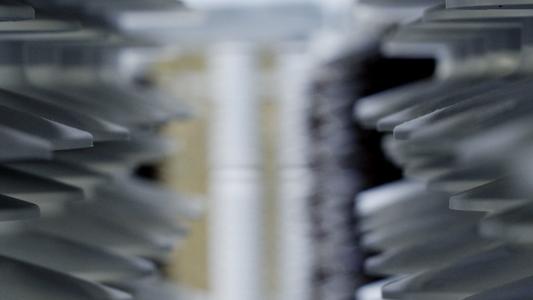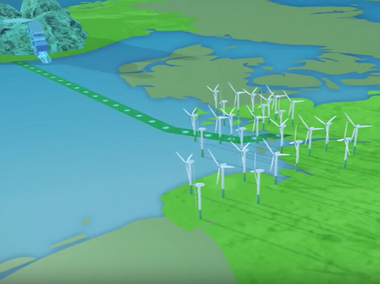Bayreuth/Hamburg. Contracts were signed today in Hamburg between NordLink partners TenneT, Statnett and KfW plus ABB as the contractor for the construction and installation of the Ger-man section of the high voltage direct current transmission cable (HVDC cable) for the NordLink project and for the two converter stations. NordLink, the “green cable”, is the first direct connection between the German and Norwegian electricity markets. The Dutch royal couple was attending at the contract signing, which took place within the framework of the international event entitled “Off-shore Wind Energy – a Contribution to the European Energy Transition”. During this congress the Dutch royal couple were updated about the modes of operation and technology involved in the use of renewable energy. Mel Kroon, CEO of TenneT Holding, said: “The royal couple’s interest in NordLink is an honour and especially exciting for us. The contract signing with our major contractor ABB could not have taken place in a more dignified setting than in the presence of their Dutch Royal Highnesses.” With regard to the integration of Europe’s electricity market Lex Hartman, member of TenneT’s Managing Board, emphasised: “With this interconnector we can exchange energy between two complementary energy systems. There’s the increasing amount of wind and solar power produced in Germany on the one hand and the production of energy from hydroelectric power in Norway on the other. NordLink is a connection of European pertinence that benefits all countries, especially North-west Europe.” “The signing today is a very important step for all partners. The interconnector will contribute to a climate-friendly and efficient electricity system of the future. It will improve power supply reliability for consumers and support added value on both sides of the interconnector,” said Statnett’s CEO, Auke Lont. Federal Minister of Economics Sigmar Gabriel said: "In addition to being an important project for the further integration of the European electricity market, NordLink also is technically unique. The direct connection enables the supply of wind power from Germany to Norway, where it is con-sumed immediately and replaces hydro power in times of supply. On the other hand, electricity from Norwegian water reservoirs can be delivered to Germany in times of high energy demand. This energy exchange via NordLink will increase the security of supply for the German and Nor-wegian power grid alike."
NordLink – the “green cable”
NordLink is being implemented as a high voltage direct current (HVDC) transmission between Germany and Norway with a route length of 623 km. Due to its length direct current will be used to transmit the electricity through both cables (positive and negative poles), which are connected to converter stations at each end. Direct current is especially advisable over long distances and for large-scale transmissions of power. The converter stations will be built in Wilster, Schleswig-Holstein/Germany, and Tonstad in Norway. At these locations the electricity will be converted from direct to alternating current or vice versa, depending on the transmission direction and fed into the German respectively Norwegian grid to supply homes and businesses with electricity. The interconnector consists of a subsea cable route that is 516 km long. In addition, 54 km of underground cable will be laid in Germany.
- ABB has been commissioned to lay the HVDC cable in the German sector (154 km of sub-sea cable and 54 km of underground cable).
- In addition, ABB has been awarded the contract to construct the converter stations in Germany and Norway.
- Nexans Norway has been awarded the contract to lay the HVDC cable in the Norwegian and Danish sectors.
- Codan will operate as the primary insurer for the project.
“Storage” of wind energy
Connecting Norwegian hydroelectric power with German wind power provides benefits for both countries. Whenever a surplus of wind energy is produced in Germany, for example, it can be transmitted via NordLink to Norway. The reservoirs in Norway then serve as natural storage for wind energy as the water remains in the reservoirs. Conversely, Germany can import hydroelectric power from Norway when demand is high.
German-Norwegian cooperation
The NordLink project is being implemented by a consortium, in which the Norwegian transmission system operator Statnett and DC Nordseekabel GmbH & Co. KG each have a 50% stake. TenneT and KfW each have a 50% share in DC Nordseekabel. DC Nordseekabel is responsible for construction and permits on the German side. The amount invested is approximately 1.5 to 2 billion Euro.
Facts and figures
- High voltage direct current transmission cable (HVDC cable) with a length of 623 km
- Capacity: 1,400 megawatts at ± 500 kV DC
- Onshore: High voltage overhead line (Vollesfjord – Tonstad/Norway) with a length of 53 km
- Offshore: 516 km subsea cable
- Onshore: underground cable (Büsum – Wilster/Germany) with a length of 54 km
- Connecting locations to the existing grid: converter stations in Wilster, Germany, and Ton-stad, Norway




